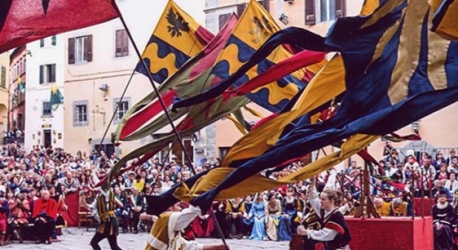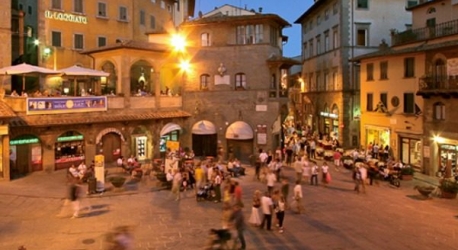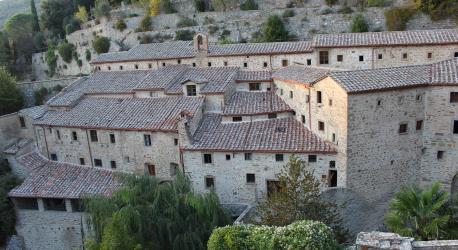Charm, vitality and beauty are three of the characteristics that make Cortona the main tourist and cultural destination of the Valdichiana of Arezzo. Located on the border with Umbria, on a strategic hilly position in the center of south-eastern Tuscany, Cortona was born as an ancient lucumonia belonging to the Etruscan dodecapolis, so much so that its name recalls the term "Curtun" which, in the Etruscan language, assumed the meaning of "enclosed place".
However, this was not the only inheritance that the Cortonese people received from the ancient inhabitants of the place. The Etruscans built the imposing walls that surround the city for about three kilometers in the fourth century BC, just as the nobles "melon" tombs scattered around the town, the monumental funerary altar adorned with sphinxes and the famous Tabula Cortonensis, a bronze sheet representing the third longest inscriptions in the Etruscan language ever found.
Declared a free municipality from the thirteenth century, the thirteenth-century history of Cortona is entirely characterized by the struggle between Guelphs and Ghibellines that accompanied this important center of the Val di Chiana until the fifteenth century, a period in which the city became part of the Florentine Republic. Nevertheless, it was only in the twentieth century that Cortona became the nerve center of a consistent movement of economic development.
Strongly linked to the surrounding territories, with the mechanization of the countryside, the municipality of Cortona inaugurates a work to enhance the products of its land. Together with a renowned wine production based on syrah vines, the exaltation of the prized "Chianina" breed of beef gives birth to one of the most popular eno-gastronomic combinations in Italy. Seat of important archaeological excavations, such as the famous Scavi del Sodo, of antiques fairs and internationally renowned festivals, Cortona is still today one of the most evocative places in the valley: a center rich in history able to combine the ancient traditions of the territory with a decidedly modern cultural vivacity.

Officially established in 1397 to celebrate the marriage between the lord of Cortona Francesco Casali and the noblewoman Antonia Salimbeni from Siena, the Giostra dell’Archidado has its origins in the Middle Ages. In the city of Cortona, this historical event is recalled every year on the second Sunday of June, when people are lead back to the ancient medieval splendor of the city. The streets are decorated in medieval style, ladies, knights, flag flyers, crossbow shooters, soldiers, pages, civil and religious authorities, all dressed with fine costumes, liven up the city center, which is rich in history and artistic beauties of every time. The five districts of Cortona participate in the event (S. Andrea, S. Marco and Poggio, Peccioverardi, S. Vincenzo and S. Maria) who, represented by two crossbowmen each, compete in Piazza Signorelli to conquer the golden arrow called “verretta”.

Since 2011, Cortona's summer has also been marked by "Cortona On The Move", the international festival of traveling photography, considered one of the most important containers for exhibitions, screenings, round table discussions and workshops on the European continent. The event has received the High Patronage of the Presidency of the Italian Republic and the honorary patronage of the Italian Ministry for Cultural Heritage and Activities and for Tourism. It brings the most interesting photographers of the world scene to exhibit in the most evocative places of the city such as the Fortress of Girifalco, the old hospital, the Meat Warehouse and the Signorelli Theater.
Set up in the premises of Palazzo Casali, the MAEC brings together the historic Museum of the Etruscan Academy and the Museum of the Etruscan and Roman City of Cortona in a single exhibition. In over 2000 square meters of exhibition space, some of the most important masterpieces of the Etruscan civilization, such as the extraordinary Etruscan chandelier, the collection of bronzes, the Egyptian section and the eighteenth-century library. The museum also manages one of the most interesting archaeological parks in Italy: a widespread park consisting of works, grave goods and mounds scattered around the city and in the surrounding hamlets.
Perfect location for readings, meetings and classical music concerts, the Sanctuary of Santa Margherita is one of the favorite destinations for tourists from all over the world. Here, in a room at the back of an ancient church of Camaldolese monk, Santa Margherita lived the last years of her life and died, in 1297. Erected on the highest part of the Cortona hill, the sanctuary still preserves the remains of the holy, inside a building of undisputed charm, symbol of the highest pictorial and sculptural expression of the Senese school.

Founded by St. Francis in 1211 at the foot of Mount Egidio, the Hermitage Le Celle is, like all Franciscan hermitages, a place surrounded by nature that invites meditation and prayer. However, inhabitants believe that the name "Le Celle" is prior to the arrival of the saint from Assisi, perhaps due to the presence of small buildings carved out of the rocks, consisting of peasant huts and mills located along the stream. The structure still appears today a remote and wild place where the houses of the friars and the conventual rooms are arranged "in steps" on both sides of the valley.
TheAssociated paths of CORTONA






